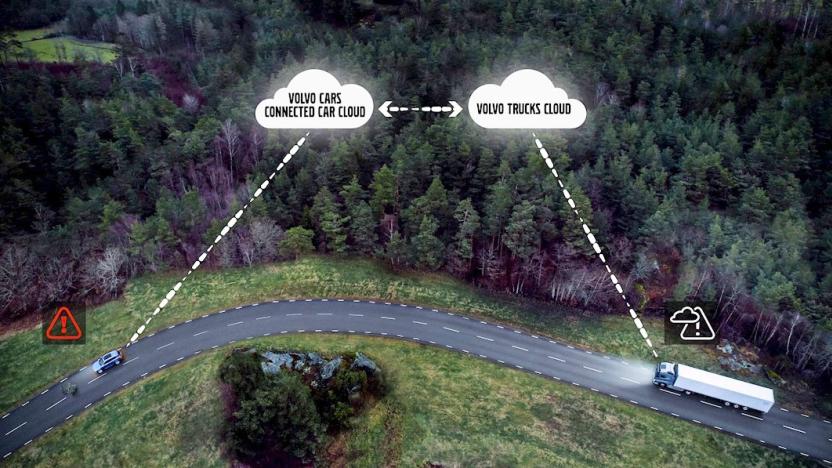VehicleToVehicleCommunications
Latest

Volvo cars and trucks can now share traffic alerts with each other
Volvo Cars announced today that some of its models will begin sharing real-time data with certain Volvo trucks. When drivers of Volvo cars with the Hazard Light Alert system switch on their hazard lights, an alert is sent to all other nearby cars with the cloud-based service. The alerts act as a warning about slowdowns or potentially hazardous accidents. Now, for the first time, Volvo Cars is sharing that data with another company -- Volvo Trucks -- which will help identify more traffic incidents and possibly improve driver safety.

It takes a smart city to make cars truly autonomous
Artificial intelligence is driving the autonomous car. Coupled with robust computers, automobiles of the future will be more powerful than any other device we own. But they'll only be as powerful as their surrounding allows. If your vehicle doesn't know about a traffic jam along its route, like its human counterparts, it'll get stuck in gridlock. That's where connectivity comes in. When self-driving cars hit the road, they'll not only be computing juggernauts but also sharing data with everything all the time.

The US wants cars to 'talk' to each other, sooner rather than later
The Department of Transportation wants America's cars to talk to each other, and it wants that to happen pretty soon. That's why Secretary Anthony Foxx has announced that legislation to make vehicle-to-vehicle (V2V) communication a mandatory feature of new cars will be brought forward. At a speech in Silicon Valley, the official added that he's greasing the wheels of government to make it easier for the program to begin. For instance, he's working with the FCC to ensure that the 5.9GHz spectrum is properly tested and ready for use when this technology eventually reaches consumers in the next few decades.

Volvo's connected cars could make winter driving safer for everyone
With its latest research project, Volvo is hoping to make driving in inclement weather a bit less dicey. The Swedish automaker is testing a safety system that uses mobile data networks to relay icy road conditions from vehicle to vehicle. Once you hit a slick spot, the location data uploads to Volvo's database and then an instant notification is sent to other cars nearing that area. As the outfit tells it, the in-car app will adjust the warning's intensity based on your speed as well as the road conditions. Meaning that, if you're crawling up the interstate at 5MPH through a whiteout, your dashboard won't light up in the way that, say, someone's would if they were doing 88MPH. What's more, the system will transmit the pavement-friction data to maintenance crews, so more (or less) salt and snowplows can be deployed in a given area, making the roads safer for everyone -- not just Volvo owners. The pilot program is limited to some 50 vehicles for now, but the firm promises that next winter the fleet'll grow "considerably."

US Transportation agency backs public use of self-driving cars, urges states to adopt legislation
The key to road safety may lie in self-driving cars. That's the general conclusion of the National Highway Traffic Safety Administration's recently released policy report which urges states to draw up legislation that encourages testing of automated autos. Currently, only three states (i.e., California, Nevada and Florida) have enacted laws that permit companies like Google to operate these vehicles on public roadways. But the NHTSA hopes that with more state-backed adoption, advances in vehicle-to-vehicle communication and automatic braking can more quickly be refined, thus paving the way for industry standards and eventual commercial deployment. The agency, an arm of the US Department of Transportation, is also conducting its own research into V2V systems and driver guidelines for self-driving cars; the first phase of which is set to play out over a four-year period. For now, though, it still has a few additional hurdles to overcome, namely consumer perception (the NHTSA estimates self-driving cars could reduce crashes by 80 percent) and possible WiFi interference from the whitespace spectrum freed up by the FCC. Though the NHTSA's sights are clearly set on an automated vehicle future, it's yet to determine whether or not inclusion and use of that tech will be mandated.




